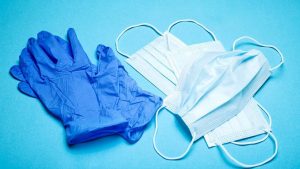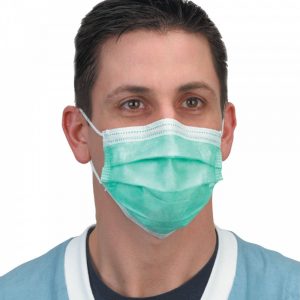
Social Distancing in Emergencies

PPE
Face coverings have become mandatory in some shops and supermarkets in England. In terms of the law, in England, people are required to wear face coverings:
For members of the public, from 8 August the places where you will have to wear a face covering will be expanded to include:
However, people with mental or physical illnesses or disabilities are exempt from the requirements — if wearing a face covering makes it difficult to breathe for example, such as in the case of respiratory conditions like asthma.
Asthma and Face Coverings – Understanding the Exemptions! A downloadable exemption card has been produced for people to show on their phones or elsewhere to explain why they’re not wearing a mask. However, people are not obliged by law to show the card if they are challenged on face masks.
Coronavirus (COVID-19) usually spreads by droplets from coughs, sneezes and speaking. These droplets can also be picked up from surfaces, if you touch a surface and then your face without washing your hands first. This is why social distancing, regular hand hygiene, and covering coughs and sneezes is so important in controlling the spread of the virus.
The best available scientific evidence is that, when used correctly, wearing a face covering may reduce the spread of coronavirus droplets in certain circumstances, helping to protect others.
Face coverings are mainly intended to protect others, not the wearer, from coronavirus (COVID-19) they are not a replacement for social distancing and regular hand washing. It is important to follow all the other government advice on coronavirus (COVID-19) including staying safe outside your home. If you have recent onset of any of the most important symptoms of coronavirus (COVID-19):
you and your household must isolate at home: wearing a face covering does not change this.
A face covering should:
When wearing a face covering you should:
When removing a face covering:
Contact us for further information.

Social Distancing in Emergencies
The UK Government’s guidance for working safely during Covid-19 states that “in an emergency, for example an accident or fire, people do not have to stay 2m apart if it would be unsafe”.
Covid-19 secure guidelines have the potential to change the fire risk profile of an organisation and the potential issues of workplace configurations during the pandemic will need to be taken into account from a fire safety perspective.
As there is a potential for change to the fire risk profile, organisations will need to review the fire risk assessment to ensure it identifies such changes and analyse the risk from the changes.
Social Distancing in Emergencies. Examples of such changes are:
The Fire Emergency Plan for the premises will need to be reviewed as part of the fire risk assessment review. Key issues in relation to social distancing are evacuation through means of escape that prevent social distancing, the evacuation of those who require assistance and the assembly point.
It is recognised that social distancing may not be possible during an evacuation due to the configuration of the means of escape. Organisations should not introduce any measures to mitigate this that make evacuation unsafe, for example by delaying evacuation.
A particular challenge may be social distancing where assistance is provided to those who require support to evacuate safely. Any Personal Emergency Egress Plan/s (PEEP) will need to be reviewed. In doing so, the organisation should take into account current official fire safety guidance and the UK Government Covid-19 secure guidelines in relation to those with “protected characteristics”.
Where close contact is necessary, immediate hygiene measures should be adopted for all those involved following the evacuation.
Assembly points
Assembly points assist in the control of occupants who have evacuated as well as enabling on-going communication and roll-call procedures, for example. The organisation should review the use of the assembly point and determine if social distancing can be maintained or whether alternative measures are required.
This could include the use of additional assembly points, marking the ground for social distancing, controlling dispersal, etc.
If you would like to have your fire risk assessment reviewed or have a new one created please contact us.
Stay Safe!

The Government have published guides to help businesses to open and work safely in regards to COVID-19. Some businesses may need more than one of the guides to ensure people are safe.
Looking through the guides they all offer similar solutions. Here we look at the top ten items to consider for your business in relation to the risk assessment.
We began the COVID-19 crisis light-heartedly washing our hands while singing a double rendition of ‘happy birthday’, but as the virus continues to hit hard, we find that hand hygiene remains front and centre. The science tells us adequate hand washing is effective but also simple, logical and cheap. It is difficult to imagine a reasonable excuse for an employer that fails in this respect.
While there have long been legal requirements to consult with employees, COVID-19 as a risk has grabbed the attention like few other hazards. The risk assessment reinforces the importance of worker input: ‘make sure you talk to your workers and their representatives to explain the measures you are taking. They can also provide valuable information on how you could control the risks’. Employers ignore this at their peril.
Social distancing is becoming an increasingly elastic concept; sometimes two metres, sometimes ‘one metre plus’ and differing throughout the UK. The document reminds employers that local rules may differ which highlights the importance of nationwide organisations remaining abreast of local updates and being agile and responsive to changes at short notice.
Virtually all jobs have changed in some way. Many of our new working practices are no doubt here to stay. There is a hint of this in the new document, which encourages the increased use of online meeting facilities, even when people are working in the same building.
Good ventilation is another basic control measure to reduce the risk. This is reflected in the risk assessment, which suggests propping open non-fire doors to improve air circulation, ushering in another important point: COVID-19 control measures should not adversely impact pre-existing safety regimes. Consider having the company fire risk assessment reviewed in light of these changes.
The document takes a huge step forward in identifying the detrimental impact of the pandemic on our collective mental health and well being. While the focus is on planning for those coming back into workplaces, huge numbers are still working from home and the importance of contact, time management and fatigue are among the hazards highlighted.
Thinking about those remote workers, the assessment also highlights the musculoskeletal disorders risked by lengthy DSE use at home. The HSE maintains that ‘there is no increased risk for people working at home temporarily’ but there is no question that this pandemic is testing the bounds of what ‘temporarily’ really means.
The all-encompassing task facing employers is laid bare by the need to identify those within the workforce who are vulnerable or clinically extremely vulnerable. The suggested control measures include an in house individual assessment of these employees and a discussion to identify what is needed in each case. Consider management and HR (If applicable) reviews.
Once again we see the attempt to stretch health and safety law beyond its typical boundaries. In identifying occasions when social distancing may be difficult, employers’ control measures are said to include the provision of facilities to keep people from public transport and creating working cohorts of those who already travel to work together.
The very last point, face coverings. These are ‘not required to be worn in the workplace’ but ‘where people choose to wear them you should support them’. The government guidance for those in close contact sectors such as hairdressing now requires the wearing of visors to ‘provide a barrier between the wearer and the client from respiratory droplets caused by sneezing, coughing or speaking’. Of course face coverings are also now mandatory on public transport too. Logically there is an acceptance that simple barriers (not PPE) have a part to play in reducing the transmission risk and a more sweeping change in the existing non-committal position feels almost inevitable.
Contact us if you require further information.
Keep safe!
(This blog was correct at time of release)

The World Health Organization (WHO) has published new advice for the public on when and how to wear masks safely.
The guidance covers fabric masks and medical masks, describing who should wear what type of mask and when.
Face coverings have become mandatory in some shops and supermarkets in England. In terms of the law, in England, people are required to wear face coverings:
Some key points for fabric masks include the following.
In addition, the WHO has advised the public of the following Don’ts with regard to fabric masks.
Don’t use a mask that looks damaged.
Don’t wear a loose mask.
Don’t wear your mask under the nose.
Don’t remove the mask where there are people within a metre.
Don’t use a mask that is difficult to breathe through.
Don’t wear a dirty or wet mask.
Don’t share your mask with others.
With thanks to The World Health Organization (WHO)
Contact us if you want to discuss Covid-19 risk assessments, social distancing signage or hand sanitiser.
Stay Safe!

The coronavirus (COVID-19) epidemic continues in the UK. As we move to the “recovery phase” or the “new normal” as it is often referred to, employers are expected to plan for the return to work of employees where they are not able to work from home.
The UK Government has published COVID-19 Secure working safely guidance for workplaces that provides a hierarchy of risk control measures that employers and the self-employed are expected to follow when reviewing their risk assessments for COVID-19 hazards.
“When managing the risk of COVID-19, additional PPE beyond what you usually wear is not beneficial. This is because COVID-19 is a different type of risk to the risks you normally face in a workplace, and needs to be managed through social distancing, hygiene and fixed teams or partnering, not through the use of PPE.
“Workplaces should not encourage the precautionary use of extra PPE to protect against COVID-19 outside clinical settings or when responding to a suspected or confirmed case of COVID-19.
“Unless you are in a situation where the risk of COVID-19 transmission is very high, your risk assessment should reflect the fact that the role of PPE in providing additional protection is extremely limited.
“However, if your risk assessment does show that PPE is required, then you must provide this PPE free of charge to workers who need it. Any PPE provided must fit properly.”
Note: Where an employer is required to provide PPE in relation to the mitigation of transmission risks from COVID-19, the requirements of the Personal Protective Equipment at Work Regulations 1992 will apply.
The UK Government has published a Coronavirus (COVID-19): Personal Protective Equipment (PPE) Plan. This contains guidance on who needs PPE, what type of PPE is required and in what circumstances. It states that PPE is “a precious resource and must be used only where there is a clinical need to do so”.
In summary, the guidance recommends that:
The guidance then states: “Beyond these roles, the current clinical evidence says there is not a widespread benefit from wearing PPE. Instead, the best way to protect yourself and others is to regularly wash your hands and to keep at least two metres between you and other people whenever you leave your house”.
The guidance on Cleaning of Non-healthcare Settings states the following.
“The minimum PPE to be worn for cleaning an area where a person with possible or confirmed coronavirus (COVID-19) has been is disposable gloves and an apron. Hands should be washed with soap and water for 20 seconds after all PPE has been removed.
“If a risk assessment of the setting indicates that a higher level of virus may be present (for example, where unwell individuals have slept such as a hotel room or boarding school dormitory) or there is visible contamination with body fluids, then the need for additional PPE to protect the cleaner’s eyes, mouth and nose might be necessary. The local Public Health England (PHE) Health Protection Team (HPT) can advise on this.
“Non-healthcare workers should be trained in the correct use of a surgical mask, to protect them against other people’s potentially infectious respiratory droplets when within 2 metres, and the mask use and supply of masks would need to be equivalent to that in healthcare environments.”
The Government’s COVID-19 Secure guidance states that covering the face may be “marginally beneficial as a precautionary measure”. The evidence indicates that wearing a face covering does not protect the wearer but may protect others if you are carrying the virus.
Face coverings are not a substitute for other forms of risk control in the workplace.
The guidance states: “Wearing a face covering is optional and is not required by law, including in the workplace. If you choose to wear one, it is important to use face coverings properly and wash your hands before putting them on and taking them off.”
Optional use includes on public transport and in some shops or other “enclosed spaces where social distancing is not always possible” and where individuals might come into contact with others that they do not normally meet.
If you require further information, on risk assessments for COVID-19 or any other topic, please contact us.